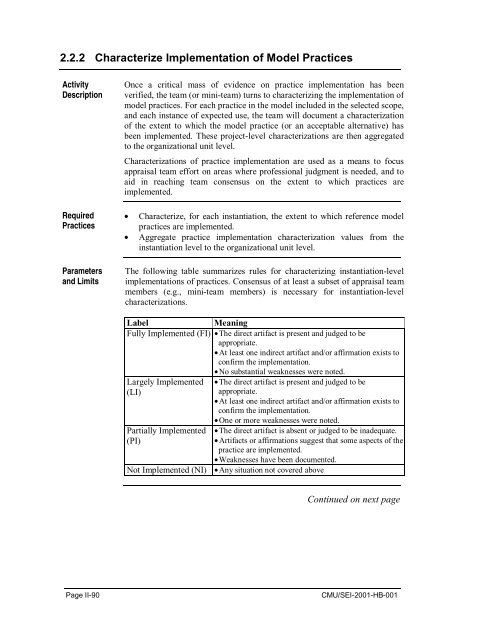Standard CMMI Appraisal Method for Process Improvement (SCAMPI)
Standard CMMI Appraisal Method for Process Improvement (SCAMPI)
Standard CMMI Appraisal Method for Process Improvement (SCAMPI)
Create successful ePaper yourself
Turn your PDF publications into a flip-book with our unique Google optimized e-Paper software.
2.2.2 Characterize Implementation of Model Practices<br />
Activity<br />
Description<br />
Required<br />
Practices<br />
Parameters<br />
and Limits<br />
Once a critical mass of evidence on practice implementation has been<br />
verified, the team (or mini-team) turns to characterizing the implementation of<br />
model practices. For each practice in the model included in the selected scope,<br />
and each instance of expected use, the team will document a characterization<br />
of the extent to which the model practice (or an acceptable alternative) has<br />
been implemented. These project-level characterizations are then aggregated<br />
to the organizational unit level.<br />
Characterizations of practice implementation are used as a means to focus<br />
appraisal team ef<strong>for</strong>t on areas where professional judgment is needed, and to<br />
aid in reaching team consensus on the extent to which practices are<br />
implemented.<br />
• Characterize, <strong>for</strong> each instantiation, the extent to which reference model<br />
practices are implemented.<br />
• Aggregate practice implementation characterization values from the<br />
instantiation level to the organizational unit level.<br />
The following table summarizes rules <strong>for</strong> characterizing instantiation-level<br />
implementations of practices. Consensus of at least a subset of appraisal team<br />
members (e.g., mini-team members) is necessary <strong>for</strong> instantiation-level<br />
characterizations.<br />
Label<br />
Meaning<br />
Fully Implemented (FI) • The direct artifact is present and judged to be<br />
appropriate.<br />
• At least one indirect artifact and/or affirmation exists to<br />
confirm the implementation.<br />
• No substantial weaknesses were noted.<br />
Largely Implemented • The direct artifact is present and judged to be<br />
(LI)<br />
appropriate.<br />
• At least one indirect artifact and/or affirmation exists to<br />
confirm the implementation.<br />
Partially Implemented<br />
(PI)<br />
• One or more weaknesses were noted.<br />
• The direct artifact is absent or judged to be inadequate.<br />
• Artifacts or affirmations suggest that some aspects of the<br />
practice are implemented.<br />
• Weaknesses have been documented.<br />
Not Implemented (NI) • Any situation not covered above<br />
Continued on next page<br />
Page II-90<br />
CMU/SEI-2001-HB-001
















